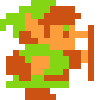Quote:Original post by Anonymous Poster
You said "As I mentioned earliers, quaternions form a four dimensional normed division algebra over the real numbers" is sufficient but what I stated is not? Can you give an example of something that forms "a non-commutative normed associative finite dimensional division algebra with identity over the field of reals" that is not a quaternion or at the very least isomorphic to it?
Sorry, I missed "over the real numbers" when I read your post the first time.






